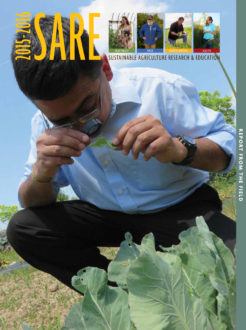SARE may be small compared to other USDA grant programs, but it consistently has an impact out of proportion to its budget. One factor in SARE’s success is the high level of continued engagement researchers have with the program; researchers and Extension specialists routinely revisit SARE as a source of grant funding for sustainable agriculture projects.
In the Southern region, this relationship is best illustrated through the Graduate Student grant program. The grant was started in 2000 to give Master’s and PhD students the opportunity to conduct sustainable agriculture research projects. It has been a vehicle to apply for other SARE grants as students further their research careers.
In a brief snapshot of the history of the Graduate Student grant program, seven students who received a Southern SARE Graduate Student grant went on to become a primary investigator or participant in future Southern SARE grant projects, as researchers or Extension specialists. As professionals, these seven former graduate student grantees received a combined $2.7 million in funding from Southern SARE, a continued investment in the next generation of leaders in sustainable agriculture research.
Grants Awarded in the South
The following is a summary of SARE funding in the South. State-by-state grant data is also available. To learn about SARE-funded activities and opportunities in Southern states, visit our state program pages. Visit the projects database to search individual projects by type, topic, state and other criteria.
Grant Proposals and Awards, 2014-20151
| Grant Type |
Preproposals
Received2 |
Full Proposals
Invited |
Full Proposals
Received |
Proposals
Funded |
Funding
Total |
| Research and Education | 153 | 48 | 43 | 11 | $2.1 million |
| Professional Development | 25 | 16 | 12 | 7 | $842,141 |
| Farmer/Rancher | N/A | N/A | 96 | 13 | $197,118 |
| On-Farm Partnership | N/A | N/A | 79 | 17 | $339,928 |
| Graduate Student | N/A | N/A | 116 | 21 | $186,484 |
|
1 The Southern region’s grant cycle is based on the year calls for proposals are released, whereas in other regions it is based on the year projects are funded. To parallel the other regions, the actual data used in this table reflects the South’s 2013-2014 funding cycle. 2 The use of a preproposal process varies by region. It serves to screen project ideas for the larger and more complex grant programs, to reduce applicants’ proposal preparation burden and the proposal review burden for SARE’s volunteer reviewers. |
|||||
Total Grants Awarded in the South, 1988-2015
| Grant Type | Grants Awarded | Total Dollar Amount |
| Research and Education | 267 | $39.1 million |
| Professional Development | 113 | $7.8 million |
| Farmer/Rancher | 276 | $2.4 million |
| On-Farm Partnership | 91 | $1.2 million |
| Graduate Student | 147 | $1.4 million |
| Community Innovation | 93 | $1.1 million |
| Regional Total | 987 | $53 million |
Alabama Extension and Farmers Partner to Battle Pests
Alabama SARE State Coordinator and Extension Entomologist Ayanava Majumdar is bringing a range of ecological pest management strategies to his state's small-scale, organic vegetable growers.
Moving Beyond a One-Size-Fits-All Approach to Cover Crops
SARE: ADVANCING COVER CROP RESEARCH Thousands of Florida growers use cover crops, mainly to capture nutrients before they reach surface and groundwater, and to reduce erosion caused by heavy rains. There is less on-the-ground research, however, to demonstrate the other benefits of cover crops, notably pest control and the nitrogen contribution of legumes. “Florida is a unique environment. […]
Vibrant Network and Useful Resources for Southern Farm Women
Annie's Project, a risk management and business skills workshop for women farmers, is taking off across the South, thanks to the efforts of a multi-state group of Extension educators.

